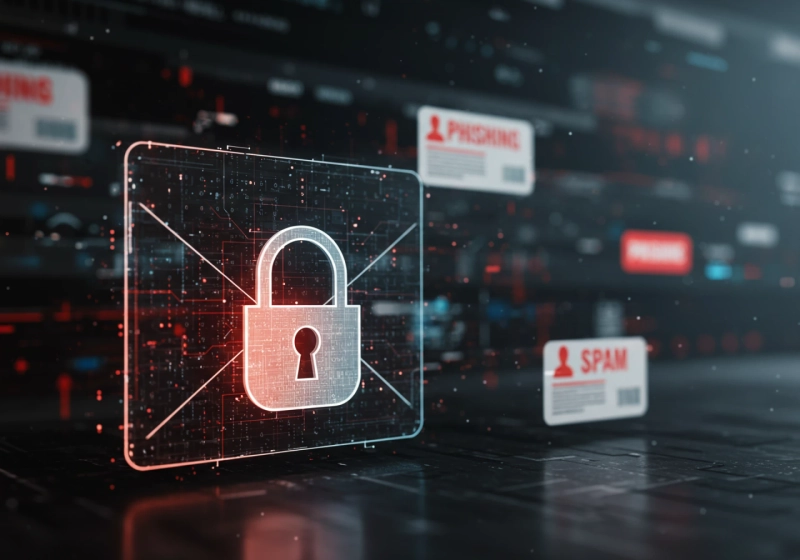Email remains one of the most essential communication tools for businesses, but it is also a prime target for cybercriminals. Phishing, spoofing, and spam attacks can lead to financial losses, data breaches, and reputational damage. Implementing strong email security best practices is crucial to protecting your business from these malicious threats.
This article explores the most common email security threats, how they work, and best practices to safeguard your organization from potential attacks.
Understanding the Threats: Phishing, Spoofing, and Spam
Phishing Attacks
Phishing is a social engineering attack where cybercriminals impersonate legitimate organizations or individuals to trick users into revealing sensitive information, such as passwords, credit card details, or corporate credentials. These emails often contain:
- Urgent requests or scare tactics (e.g., “Your account has been compromised!”)
- Fake login pages that steal user credentials
- Malicious attachments or links that install malware
Email Spoofing
Spoofing occurs when attackers forge the sender’s email address to make their emails appear as if they are from a trusted source. Spoofed emails often bypass spam filters and trick recipients into transferring money, sharing confidential data, or downloading malware.
Spam and Malware Attacks
Spam emails flood inboxes with unwanted messages, advertisements, or harmful links. While some spam is merely annoying, others contain malicious software (malware) that can infect systems with ransomware, keyloggers, or other harmful programs.
Now that we understand the risks, let’s look at how to protect your business.
Best Practices for Preventing Email-Based Attacks
Email best practices can be difficult to navigate. Consider using a company specializing in email best practices to help your business proactively prevent issues with the most important communication method: email.
1. Implement Strong Email Authentication Protocols
To prevent spoofing and unauthorized use of your domain, your business should implement email authentication protocols:
- SPF (Sender Policy Framework): Verifies that an email comes from an authorized mail server.
- DKIM (DomainKeys Identified Mail): Ensures the integrity of email content and verifies the sender’s domain.
- DMARC (Domain-based Message Authentication, Reporting & Conformance): Helps prevent spoofing by defining how recipient mail servers should handle unauthenticated emails.
These authentication measures increase email security and reduce the risk of phishing and spoofing attacks.
2. Use Advanced Email Filtering Solutions
Investing in enterprise-grade email security solutions helps block phishing, spoofing, and spam emails before they reach users. Advanced email filtering tools:
- Use AI-driven threat detection to identify suspicious emails
- Scan attachments and links for malware
- Block known phishing domains and spam senders
Popular email security solutions include Microsoft Defender for Office 365, Google Workspace Security, and Proofpoint Email Protection.
3. Educate Employees on Email Security Awareness
Employees are the first line of defense against email threats. Conduct regular cybersecurity training to help staff recognize and report suspicious emails. Training should cover:
- How to identify phishing attempts and fake links
- The dangers of clicking unexpected attachments
- Verifying the sender’s identity before responding to urgent requests
- Reporting phishing emails to IT teams
A well-trained workforce reduces the risk of human error-based security breaches.
4. Enable Multi-Factor Authentication (MFA)
Even if credentials are stolen through phishing, MFA adds an extra layer of security by requiring a second verification step (e.g., an SMS code or authentication app). Enforcing MFA across email accounts, cloud platforms, and business applications greatly reduces the risk of unauthorized access.
5. Regularly Update and Patch Email Systems
Cybercriminals exploit vulnerabilities in outdated email servers and applications. To prevent attacks:
- Ensure email servers and software are always up to date.
- Apply security patches as soon as they are released.
- Use up-to-date antivirus and anti-malware solutions to detect potential threats.
6. Implement Email Encryption for Sensitive Communication
Unencrypted emails can be intercepted by hackers. To secure sensitive business communications, use:
- End-to-end email encryption (e.g., PGP or S/MIME)
- Secure file-sharing platforms for sending confidential documents
- Virtual Private Networks (VPNs) for added security when accessing business emails remotely
7. Establish an Email Security Policy
A clear email security policy ensures all employees follow best practices when using business email accounts. Your policy should include:
- Guidelines for password complexity and expiration
- Rules for handling sensitive information via email
- Steps for reporting suspicious emails
- Procedures for responding to a phishing attack or data breach
Having an organization-wide email security strategy helps standardize protection measures and reduces the risk of accidental data exposure.
8. Monitor and Respond to Threats Proactively
Businesses should continuously monitor their email environment for suspicious activity. Key security measures include:
- Setting up real-time email threat detection alerts
- Conducting regular security audits
- Analyzing email logs for signs of unauthorized access or unusual email activity
Implementing a Security Information and Event Management (SIEM) system can help automate threat detection and response.
9. Use Sandboxing to Test Attachments and Links
Sandboxing is a cybersecurity technique that allows businesses to analyze suspicious email attachments and links in a secure environment before opening them. Email security gateways use sandboxing to detect:
- Zero-day malware
- Embedded ransomware
- Malicious macros in attachments
This approach prevents infections before they spread to the network.
10. Implement a Robust Backup and Disaster Recovery Plan
Even with strong security, email-related data loss can occur due to attacks or human error. Protect your business by:
- Regularly backing up email data
- Using cloud-based email continuity services to ensure access during outages
- Having a disaster recovery plan to quickly restore operations after an attack
Being prepared for worst-case scenarios minimizes disruptions and ensures business continuity.
Email remains one of the most targeted attack vectors for cybercriminals, making strong email security practices essential for businesses of all sizes. By implementing email authentication protocols, employee training, multi-factor authentication, and advanced filtering tools, organizations can effectively reduce the risk of phishing, spoofing, and spam attacks.
Taking proactive steps to secure your business email system not only protects your organization but also strengthens customer trust and regulatory compliance. Investing in robust email security solutions today can save your business from costly breaches and downtime in the future.


